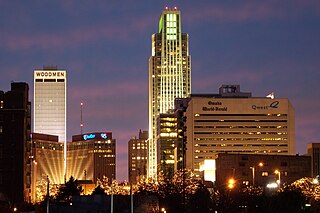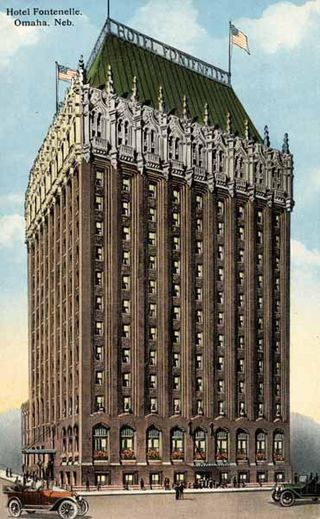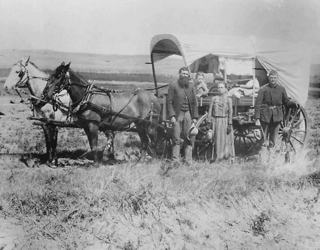History
The first known German in the Omaha area arrived more than 20 years before the city was founded. Prince Maximilian of Wied-Neuwied toured the Upper Missouri River in 1832, and recorded a stay at Cabanne's Trading Post in present-day North Omaha. [6] After arriving in Omaha en masse beginning in the 1860s, Germans in Omaha built their own churches. At church and in their businesses, including grocery stores and farm supply shops, they conducted daily life in German for years. Many young German immigrants from Omaha served in the Nebraska battalion during the Civil War, [7] as well as later serving throughout the country.
One early German settler in Omaha was Vincent Burkley. (He anglicized his name). After working as a grocer and farm laborer for three years starting in 1854, he opened his own printing company. He was almost immediately successful. [8] Burkley was elected as a member of the Omaha City Council for several years, [9] as well as the Omaha Board of Education. [10]
Communities
In the earliest days of Omaha, the "heart of the German settlement was in the large concentration between South 10th and 13th Streets. Here one could purchase food from several German merchants, including Volkmier's Meat Market, Schmid's Grocery, and the Schube Haus (bakery) ... The Emmel House (hotel) and Hottenroth and Bauer Boarding House were also located in this core". [11] The area south of the railroad corridor and west of South 16th Street contained an area of German Catholics. This settlement was centered on South 16th Street and Center Street and includes St. Joseph's Church, which was established in 1887 to serve German-speaking Catholics. Protestant Germans settled in a concentration centered on South 11th Street and Center Street, and built a German Methodist Episcopal Church in 1886. [12]

By 1900 Germans lived in more dispersed neighborhoods, including the Near North Side neighborhood, Florence, and South Omaha. Within 25 years they lived throughout the city, with large enclaves in the Dundee and Field Club neighborhoods. [13] Another "concentration was ... near South 19th and Vinton Streets ... The Bongardt Meat Market, Schmidt Saloon and Muller's Hall were located in the 1700 block of Vinton. Wilg Dry Goods was at 1810 Vinton, Strausburgh Druggist at 1822 Vinton, and the Schouboe Bakery at 3130 S. 18th St." [14]
Culture
Germans built several Deutschekirchen - German churches - throughout Omaha. [5] St. Joseph's was a Roman Catholic parish established in 1901 to serve Omaha's German-speaking Catholics. [15]
The German community in Omaha was literate and large enough to support several German-language newspapers, which also had national distribution. They included the Omaha Tribune, the Volkszeitung Tribune, and the Sonntagspost, which was later called the AmericaHerold. [16]
Edward Rosewater, the Czech editor at The Omaha Bee, used the slogan "Germania our Mother, Columbia our Bride" to describe the kind of "dual-sentimentality" many Germans in America felt toward their country of origin. [17] In the early 20th century, German immigrants came to Omaha for work and to escape state oppression led by Kaiser Wilhelm in Germany. [18]
The German community in Omaha was noted for settling quickly throughout the city. Period sociological research also identified a range of reluctance among some German immigrants, as well as second- and third-generation Germans towards assimilation. [19] During the early 20th century, Germans in Omaha were successful in ensuring that German culture, German history and German language lessons were included in the local public school system, because they comprised a large part of the electorate. [20]
Employment

Germans in Omaha were employed in many of the city's manufacturing industries, particularly its brewing sector, which was created by German immigrants. Leading German employers in the city included the Metz Brewery, Krug Brewery and the Storz Brewery. Gottlieb Storz, Frederick Krug and Frederick Metz built the success of their breweries by hiring German brewmeisters and laborers for their skills. [21]
Many Germans in the Omaha area also worked at the Union Stockyards, and in farming in Douglas County. [18] In 1910 the Union Stockyards reported to the United States Immigration Commission that 14.1% of its workers were German immigrants. [22] Numerous Germans worked at German-owned beer gardens, dry goods stores, farms, and milling operations throughout the city and Douglas County. [19] The German work ethic was highly regarded throughout the city. Immigrant workers from Germany were readily employed in Jobbers Canyon and by the railroads in Omaha. [13]
Politics
German-owned breweries in Omaha sought to keep alcohol legal at a time when political pressure was widespread to establish Prohibition. German voters in Omaha were largely responsible for the election of Nebraska Governor Ashton C. Shallenberger in 1908, as Shallenberger ran on an anti-Prohibition slate. After he was elected, however, Shallenberger became pro-Prohibition. Temperance was strongly supported in most of Nebraska for 30 years before the national Prohibition movement. [23] A statewide election seeking a prohibition of alcohol in 1890 won in almost every county across the state, except Omaha's Douglas County. The German vote there was credited for keeping the state "wet" during that period. [24] When William Jennings Bryan returned to Nebraska after his third unsuccessful Presidential campaign in 1908 to advocate for Prohibition, he became "the arch enemy of das Deutschtum." [5]







